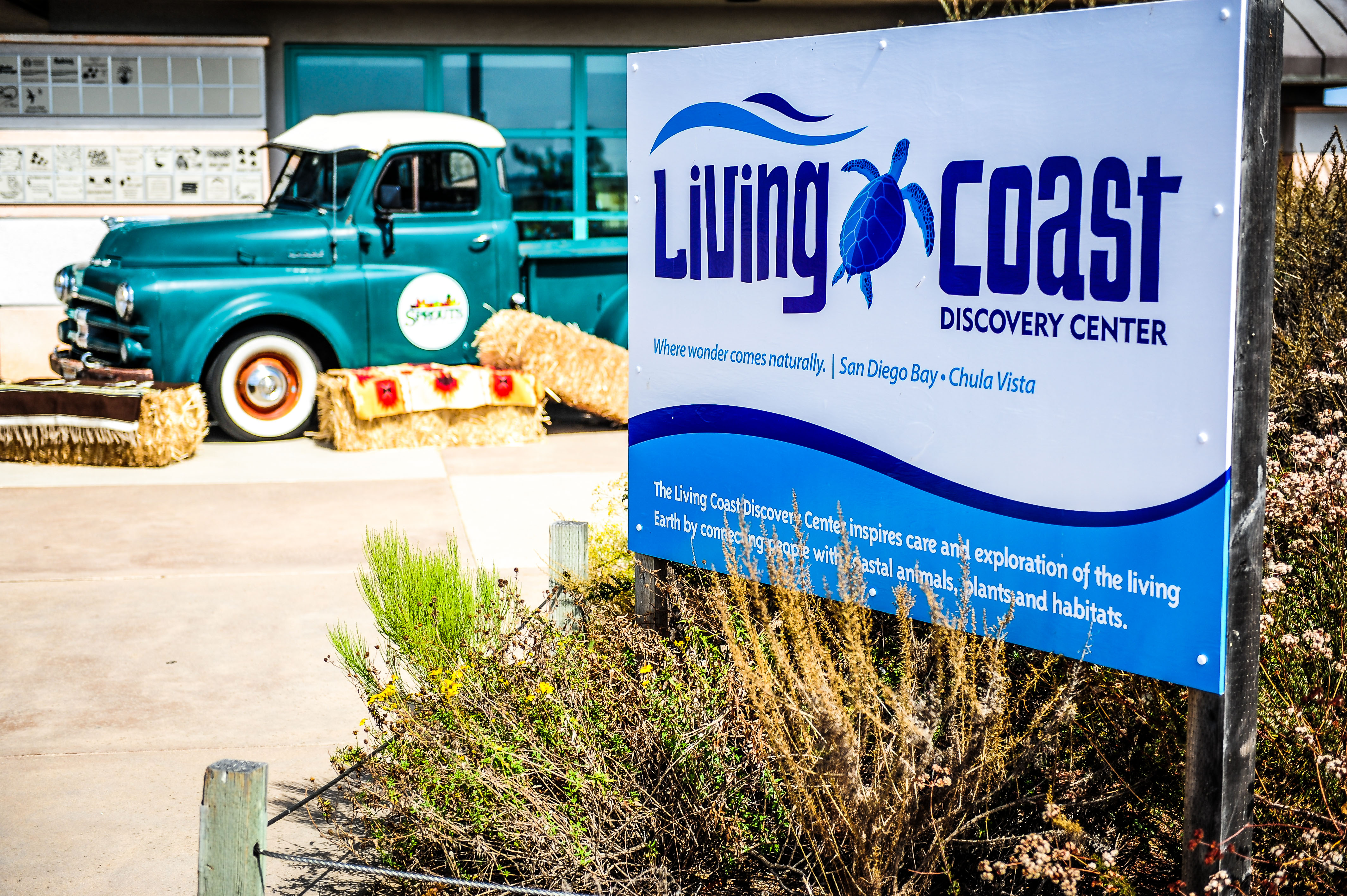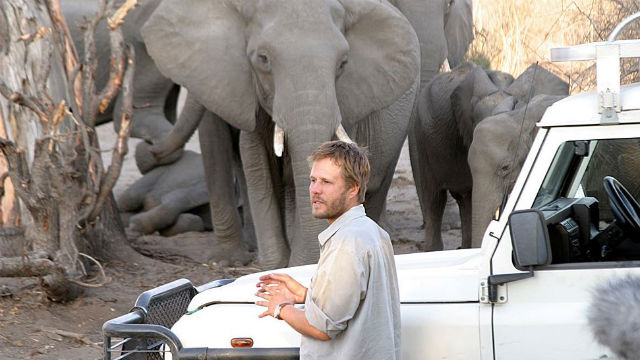Daily Business Report-Aug. 21, 2015
Navy Secretary Ray Mabus speaks before signing the agreement with Sempra. (Photo by Chris Jennewein)
Sempra to Power Navy, Marines
With Solar Energy in Record Sale
Times of San Diego
Sempra Energy signed an agreement Thursday to provide a record amount of renewable, solar energy to 14 Navy and Marine Corps installations in California.
The bases will get a third their energy requirements from a 210-megawatt solar installation located 60 miles west of Phoenix. The Mesquite Solar 3 project, comprising more than 650,000 photovoltaic panels, will be complete by the end of 2016.
“We are going to build you a beautiful, efficient plant,” said Patti Wagner, president and CEO of Sempra U.S. Gas & power, noting that it’s the largest federal purchase of renewable energy ever.
Wagner and Navy Secretary Ray Mabus signed the agreement during a ceremony at Naval Base Coronado, with the carriers USS George Washington, USS Carl Vinson and USS Ronald Regan in the background.
“Behind me are three great examples of renewable energy,” said Mabus, noting that the Navy has been in the forefront of developing new energy sources, from sail power to coal to oil to nuclear energy and now solar.
“Every single time we switched energy course, there were naysayers,” he said. “Every single time those naysayers were wrong, and they are wrong this time.”
He said the U.S. military is the world’s largest user of fossil fuel, and therefore is focused on both saving money and ensuring secure supplies.
Mabus praised the efforts of Rep. Scott Peters in helping the Navy exploit renewable energy. Peters, who serves on the House Armed Services Committee, said no one would consider the Navy and Marines to be “tree huggers,” but developing renewable energy is important for America’s long-term security.
“By investing in alternate sources and diversifying their energy supply portfolio, the DOD can lead the way in advancing renewable energy technologies,” Peters said.
The 25-year purchase agreement with Sempra is expected to save the Navy up to $400 million compared to traditional energy sources.
In 2009 Congress mandated the Department of Defense to procure 25 percent of its energy requirements from renewable sources by 2025.
__________________________________________

Homes Unaffordable in All
But Seven California Counties
Times of San Diego
Only seven of California’s 25 counties — mostly in the Central Valley and far north — have homes affordable to buyers who earn the median household income, the California Association of Realtors reported Thursday.
“The significant disparity between what home buyers can realistically afford and actual home price is discouraging, especially in the San Francisco Bay Area,” said Chris Kutzkey, president of the association.
“While housing is affordable in some regions of the state, California lacks an adequate supply and mix of affordable housing in locations where the majority of the state’s workforce resides,” she added.
In the second quarter of 2015, the statewide median price of $446,980 was nearly 50 percent higher than what a California household with the median income of $60,244 could afford to purchase.
The only counties where homes are affordable were Kings, Merced, San Bernardino, Tulare, Shasta, Fresno and Madera.
San Francisco was the least affordable county in the state. Families earning that county’s median income of $75,910 could afford a $383,670 home, but a media priced home there costs three times more — $1,247,570.
San Diego isn’t nearly as bad off, with the median income of $61,770 able to afford a $312,180 home, and the median priced home costing about 50 percent more at $475,230.

Economic Impact of Aging Baby Boomers
Focus at 1st North County Health Care Summit
Neurologist Dr. Michael Lobatz of Scripps Health, who played an integral and leading role in the county of San Diego’s comprehensive Alzheimer’s Project, will be one of the panelists at the first North County Health Care Summit to be held on Tuesday, Sept. 29, from 7:30 to 10:30 a.m. at the Veterans Association of North County.
The event will focus on “The New Economy of Aging Baby Boomers” and will comprise two panels featuring:
• A clinical perspective of the state of the nation, California and our region – from a healthcare perspective — where we are now, what we need to do to serve the aging baby boomers, and what the future will look like.
• How North County is preparing for the future impact of our growing aged. What is the economic impact-a prediction of the statistics; plus what does the future hold for jobs, facilities, education and infrastructure? How will the region prepare and respond?
The panels will be moderated by San Diego Union-Tribune health care writer Paul Sisson.
Tickets are free with required RSVP. Click here.

Downsized One Paseo Unveiled
CARMEL VALLEY — Developers of the potentially precedent-setting One Paseo mixed-use project on Wednesday unveiled a downsized version they hope will soften community opposition that led to a referendum this spring.
The revisions would shrink the square footage of One Paseo about 25 percent, from 1.45 million to roughly 1.1 million, but traffic created by the project would decrease 45 percent, from 24,000 vehicle trips per day to less than 14,000.
The sharper drop in traffic results from the developer making most of the reductions to the Carmel Valley project’s retail and office components, which generate significantly more vehicle trips per day than housing units of the same size.
Square footage devoted to office buildings would decrease from 493,000 to 280,000, and square footage assigned to retail would shrink from 199,000 to 95,000. The project would continue to have 608 condos and apartments, with the total square footage of those units projected to remain somewhere between 600,000 and 800,000.
The revised proposal, which was unveiled Wednesday night at a meeting of the Carmel Valley Community Planning Board, falls within the parameters of a May agreement between the developer and opponents that prevented the referendum from going to a vote.

Historic Pack Loft Building in
East Village Sold for $4.7 Million
JS Capital Enterprises Inc. of Los Angeles has acquired the 20,000-square- foot, four-story building at 701 Island Ave. in East Village for $4.7 million. The historic building is commonly known as the “Pack Loft Building/ Bledsoe Company Furniture Warehouse.”
The seller of the 5,000-square foot parcel was Bledsoe Warehouse LLC, an affiliate of Cisterra Development.
The Pack Loft Building underwent a partial restoration and renovation by Cisterra Development in connection with the construction of the adjacent and contiguous Sempra Energy headquarters building. JS Capital Enterprises plans further renovations of office over ground-floor retail with an anticipated delivery date of February 2016.
“With the new Sempra Building, planned Whole Foods and Ritz Carlton Development, and the recently completed Unicorn Building all on the same block as the Pack Loft Building, this property is at the center of the Ballpark redevelopment renaissance,” said Bill Shrader of Colliers International, which represented the seller.
JS Capital Enterprises is an affiliate of JS Western Retail Investments in Los Angeles.

Living Coast Discovery Center
Raises Record $96,000 at Annual Event
The Living Coast Discovery Center, a nonprofit zoo and aquarium in Chula Vista, said it raised $96,000 in net proceeds at its annual Farm to Bay event on Aug. 8, making it the most successful fundraiser in the center’s history.
The funds were generated through a combination of sponsorships, ticket sales, auction proceeds and Raise the Paddle donations and will be used to support coastal wildlife, education and sustainability programs at the Living Coast throughout the year.
More than 400 guests attended the event, now in its sixth year, with Chef Nicolas Bour from Loews Coronado Bay Resort serving as culinary chair. Over 40 restaurants, craft breweries, wineries, distilleries and farms participated.

Zoo Honors 2 Men Who Dedicate
Their Lives to Saving Elephants
City News Service
Two field biologists and researchers who dedicated their lives to saving elephants were awarded conservation medals Thursday by San Diego Zoo Global.
Iain Douglas-Hamilton, founder of Save the Elephants, and Michael Chase, who started Elephants Without Borders, were honored at a luncheon.
Since 1966, the conservation medal awards program has recognized leaders who share San Diego Zoo Global’s vision to end species extinction.
Douglas-Hamilton, who started Save the Elephants in 1993, was honored for lifetime achievement.
He and his organization have contributed to legislation against ivory trade and importation, and have been leading efforts to end the poaching crisis faced by elephants.
At the age of 23, Douglas-Hamilton completed the world’s first in-depth scientific study of elephant social behavior, based on pachyderms in Tanzania’s Lake Manyara National Park.
After earning his doctorate in zoology from the University of Oxford, Douglas-Hamilton went on to investigate the status of elephants throughout Africa in the 1970s. The zoo said he chronicled how Africa’s elephant population was cut in half between 1979 and 1989.
Chase was honored for “conservation in action” — providing data on the status of elephants and other wildlife, identifying cross-border corridors and discovering new migration routes.
He is also the principal researcher who coordinates the Great Elephant Census, which started two years ago, spans 21 countries and is expected to conclude later this year.
“This (medal) came as an unexpected surprise and I’m overwhelmed — it’s a tremendous honor,” Chase said. “This award does come with a very generous gift, and I hope to use the money to establish the first elephant and rhino sanctuary in Botswana that will rehabilitate and reintroduce orphaned animals back into the wild.”
The zoo said the medals come with a $10,000 cash award.




